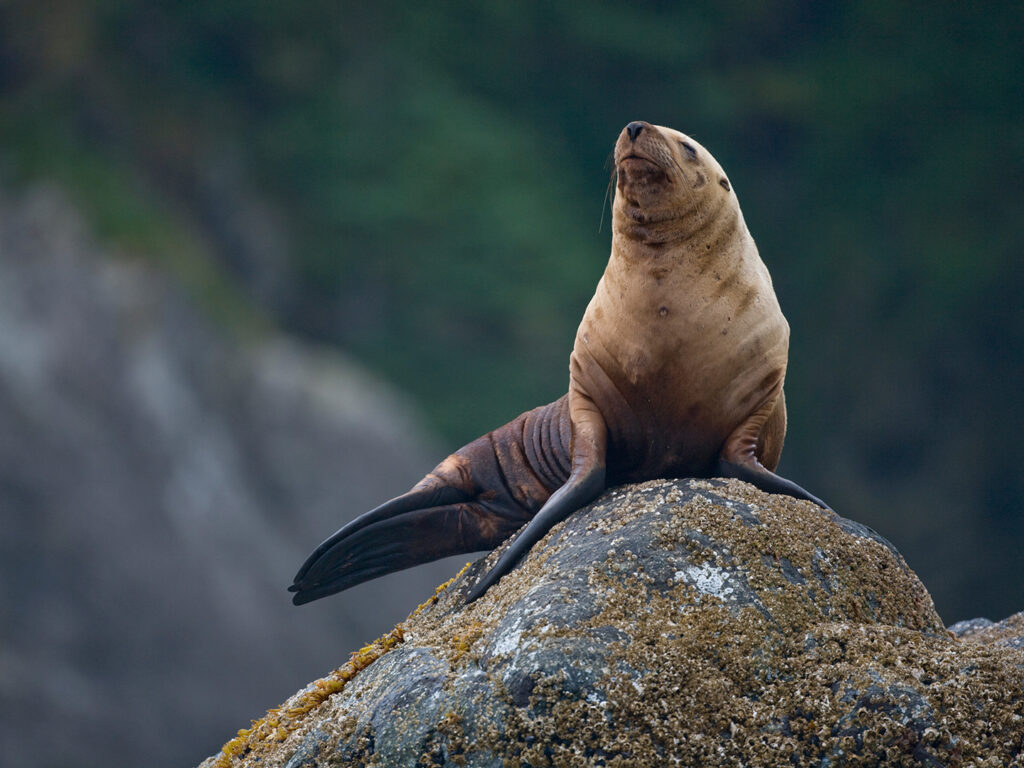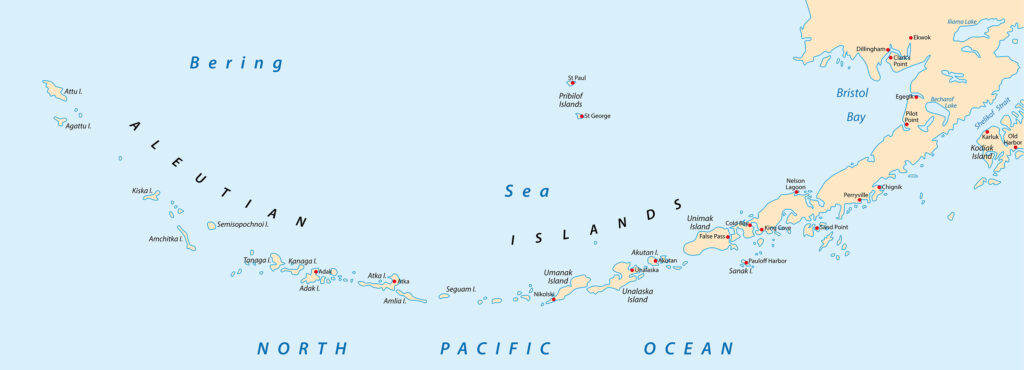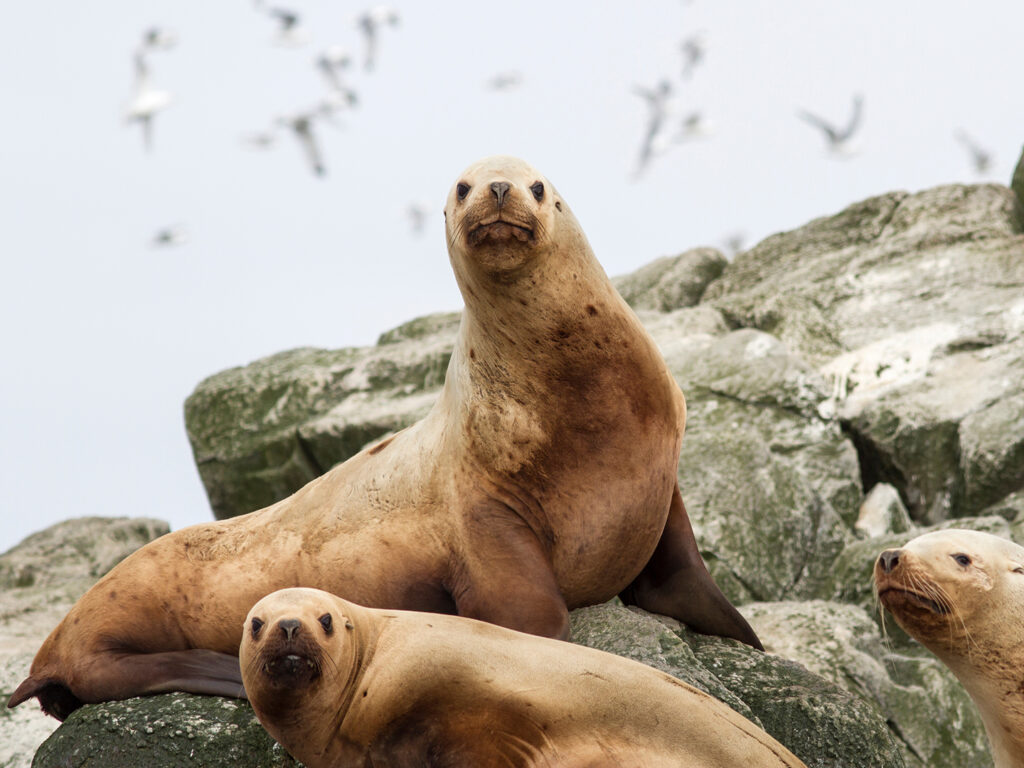Rising Mercury Levels May Contribute To Declining Steller Sea Lion Populations; International Research Team Investigates
Story by Rachel Knight, VMBS Communications

A team of researchers from Texas A&M University and beyond has made a surprising discovery about rising mercury levels in Steller sea lion pups that may have detrimental effects on the endangered species.
The team’s decade-long effort to study mercury in Steller sea lions in the Aleutian Islands — the strip of islands stretching between Russia and Alaska and separating the Bering Sea and Pacific Ocean — has revealed that the number of pups born with potentially dangerous levels of mercury in their blood and fur increased by more than 50% from 2011 to 2018 before leveling off in 2019.
Mercury — a “heavy metal,” non-essential element — can be toxic to some animals, including humans, at high concentrations. Various forms of mercury can be introduced into the environment via emissions from human activities; it can also be introduced naturally through seismic activity (like volcanoes) and melting permafrost, making it harder to pinpoint the cause of it increasing in the food web.
Before joining the Texas A&M faculty as a professor of veterinary toxicology in the School of Veterinary Medicine and Biomedical Sciences (VMBS), Dr. Todd O’Hara was a toxicologist in Alaska who conducted studies on whether mercury levels were safe in the ocean and the food web.
“While our findings haven’t indicated an immediate threat to humans via what we eat from this part of the ocean, they have raised questions about how mercury and other elements may continue to change in some of the fish we eat now as rising ocean temperature trends continue,” O’Hara said
The levels of mercury found in the pups in a largely remote area led the team to extend its research efforts in search of the cause and to examine changes in other elements in Steller sea lion populations.
The team is trying to determine whether there is a correlation between higher mercury levels in sea lion pups and population decline.
‘Heavy Metals’ And Health
Steller sea lions were added to the endangered species list in the 1990s, but their populations began recovering in some parts of the Aleutian Islands in the early 2000s, with the eastern distinct population being delisted in 2013. To discover why some groups remained in decline, researchers teamed up with the National Oceanic and Atmospheric Administration (NOAA) and commercial fisheries via Ocean Peace Inc. to gather information about the different populations from rookeries where pups and their prey are studied.
“When we started this research in Southeast Alaska, we found very few pups with alarming levels of mercury,” said Dr. Lorrie Rea, a research professor at the University of Alaska Fairbanks (UAF) who plays a significant role in the team’s Steller sea lion research program. “Once we got to the Western Aleutian Islands, we found pups with mercury concentrations that were three to four times higher than the highest we saw in other regions. As we moved toward Russia along the Aleutian Island chain, the concentrations went down again, so it’s almost like a bell-shaped curve.”
The researchers had discovered a region of higher mercury concentrations in Steller sea lion pups along this island chain.
The researchers also found that among the populations in the different regions of the Aleutian Islands, those with higher mercury levels overlapped with the populations still struggling to recover their numbers. This led the team to investigate mercury increases as a possible contributor to the sea lion’s lack of population recovery.
The team found a relationship between Steller sea lion pups with high mercury levels and certain kinds of fish in their mothers’ diets.
O’Hara said the major concern is the transfer of mercury to the fetus, which is vulnerable to adverse effects.
“Mercury is known to negatively impact immune health in humans, and one of Todd’s graduate students, Stephanie Kennedy, determined that it has a similar effect in animals like Steller sea lions,” Rea said.
Mercury levels can also affect the body’s ability to resolve oxidative stress, which harms overall health by keeping antioxidant levels relatively low and causing tissue breakdown over time. Thus, the team decided to include many essential elements, such as selenium, in the research effort.
“Oxidative stress is especially important for diving mammals such as sea lions because they go through long breath holds when they go to forage, or hunt, for fish,” Rea said. “The longer breath holds use up a lot of oxygen, so having this ability to counter the oxidative stress is important for their everyday foraging.”
O’Hara said many selenium-dependent processes are known to be involved in this protection and also plays a role in protecting from mercury toxicosis, or poisoning.

Metal Detectors
After discovering differences in mercury levels between Steller sea lion populations at different points along the Aleutian Islands, the team set out to determine if other elements also varied in pups.
The team worked with Dr. Daniela “Hanny” Alejandra Murillo Cisneros, a post-doctoral researcher at Centro de Investigaciones Biológicas del Noroeste located in La Paz, the capital city of Baja California Sur, Mexico.
Cisneros is lead author on a recently submitted manuscript reporting on these elements in Steller sea lions. She uncovered differences in numerous elements in hair and blood of Steller sea lion pups among populations across the regions of the Aleutian Islands. In hair, all 12 elements measured were different by region, except zinc, based on a distinct oceanographic feature, Amchitka Pass.
Her discovery showed that the geographic locations of the populations are playing a significant role in the Steller sea lions’ exposure to both nonessential elements, which are potentially toxic, and essential elements, which are required for good health. Thus, investigators need to consider deficiencies of essential elements and not just those that may be harmful or toxic.
“You are what you eat, and this research reflects that,” Cisneros said. “What we found is that there are significant chemical composition differences in the food sources available at each of these regions, and those differences are being reflected in Steller sea lion populations. We are taking a very close look at prey now, and some of the prey species are important food for humans.”
Cisneros’ elemental discoveries also provide evidence that the oceanic Amchitka Pass — located near the center of the Aleutian Islands where the previously mentioned “bell-shaped curve” spikes in Steller sea lion pup mercury levels — is functioning as a barrier beneath the ocean’s surface that seems to drive the varying chemical composition of Steller sea lions east and west of the pass.
“We can’t visually see some of the barriers or divisions in the ocean because they’re so deep and they’re so complicated,” O’Hara said. “Based on our studies in fish and Steller sea lions, we’re showing that this simple pass has divided the ocean biologically, physically and chemically.”
Implications For Human Health

Fish in grocery stores around the world come from the same waters that Steller sea lions forage in, making it important for humans to pay close attention to mercury and other elements in the Steller sea lion diet. The team considers the sea lion as an environmental sentinel.
Thankfully, the fishing industry is helping research teams study mercury levels by donating fish to academic research and financial support for the trace elements analysis conducted at the VMBS. So far, commercial fisheries have donated about 1,500 fish from the Aleutian Islands region.
“Everyone working on finding these answers, from the researcher to NOAA to the fisherman who donate fish, we all want science-based decision making,” O’Hara said.
Because of the support from the fishing industry, the researchers have been able to test the donated fish for diet markers, mercury and trace elements such as selenium.
“The good thing for human health is that of the 1,500 fish, we only found about 13 that had mercury concentrations that were above the levels advised for human consumption, and most of the 13 were yellow Irish lord, which is a spiny fish not typically included in fish sold to humans,” Rea said.
Fishing For Answers
The researchers emphasize that they’re not jumping to conclusions about what’s causing the rising mercury levels or the stalled sea lion population recovery on some islands.
“It’s important to note that these findings so far prove correlation, or that these things happened at the same time, not causation, which would mean one event caused the other,” O’Hara said.
As the research team continues its work in the Aleutian Islands, O’Hara, Rea, and Cisneros said they’re thankful for the collaborative nature of their work as toxicologists.
“Discoveries like this and the continued hunt for answers really takes a village,” Rea said. “This research brings academics from around the world together who contribute multiple perspectives as well as support from various industries and agencies with a vested interest in what we’re finding.”
The teams learn from each other across the border to determine what are the best approaches to understanding trace elements in the Pacific Ocean and changes in the ocean temperature and pH.
O’Hara said this work highlights the fact that how people impact the ocean has many potential effects that are not intuitively obvious, and changes in mercury levels in ocean life may be driven by many factors.
“We find answers in individual projects, but they come together like puzzle pieces to build a bigger picture,” Rea said. “We won’t fully understand what’s happening with Steller sea lions until we understand what’s happening to their environment, so there’s a lot more work to be done with other agencies and continuing our academic and industry collaboration is key to our success.”
Other researchers involved with discovering the regional differences include those from the Trace Elements Research Laboratory (TERL) in the Department of Veterinary Integrative Biosciences (VIBS). The related and relevant work in Mexico (led by Cisneros) includes published mercury and selenium concentrations findings in free-ranging California sea lions in the Gulf of California, Mexico. Contributors to the international research in Mexico and Alaska include Dr. Robert Taylor, TERL director; Dr. Jill Hiney from VIBS; Dr. Carlos A. Rosado Berrios from VIBS; Dr. Ben Barst from UAF; and graduate student Michelle Trifari from UAF; among many others.
###
For more information about the Texas A&M School of Veterinary Medicine & Biomedical Sciences, please visit our website at vetmed.tamu.edu or join us on Facebook, Instagram, and Twitter.
Contact Information: Jennifer Gauntt, Director of VMBS Communications, Texas A&M School of Veterinary Medicine & Biomedical Sciences, jgauntt@cvm.tamu.edu, 979-862-4216


